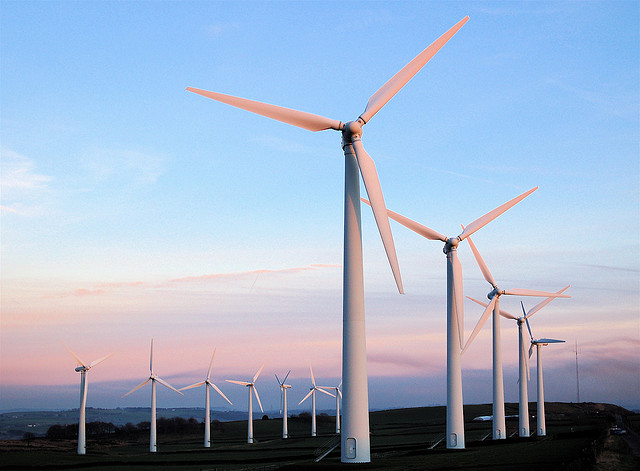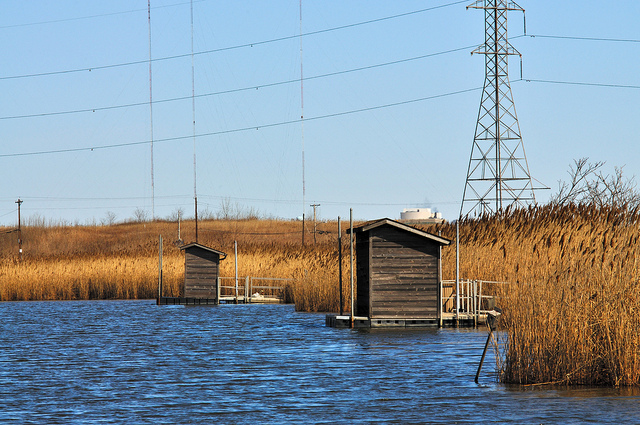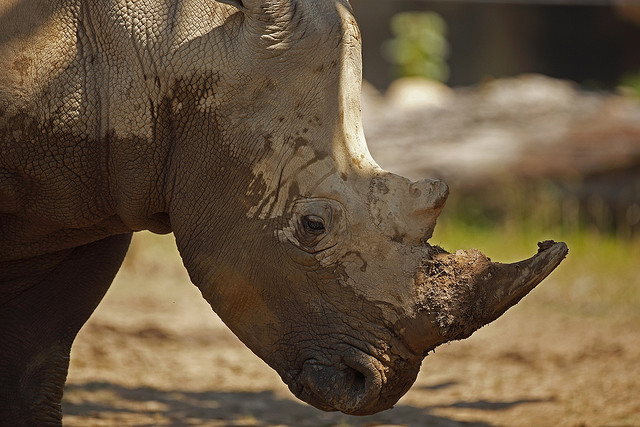
Wind Turbines in neat row arrangement. Photo Credit: Some rights reserved by Charles Cook via Flickr.
A team of researchers has found a way to increase wind turbines’ efficiency by 33% simply by changing the turbine arrangement.
Environmental News Network reports the work of Dr. Cristina Archer, Assistant Professor at the University of Delaware, and her team on wind turbine arrangement optimization. Wind currents and the right turbine placement are essential to get the most out of wind energy resources. The team experimented with organizational placements of the turbines, comparing grid-like layouts to six other alternative patterns. They conducted virtual simulations factoring in currents, eddies, and choppy wind swirls generated by the downdraft of nearby turbine blades. Dr. Archer’s team found that efficiency was maximized combining two approaches. First, a generous amount of space was kept between each turbine. Second, the turbines were placed in a staggered theatre style where each turbine does not block the view of the turbine behind it. In this way, the team recorded an efficiency increase of 33 per cent, fully a third of the turbines’ maximum energy potential.
Dr. Archer team’s findings are significant in tackling efficiency and economic barriers to widespread wind energy use. When energy yields are susceptible to factors such as minor changes in wind speeds and terrain structure among others, a lot of the weight falls on to optimizing whatever energy potential is available. This includes experimenting with turbine arrangement as well. Optimization of wind turbine arrangement is configured to achieve the highest possible yield of wind energy over the wind farm’s service lifetime. Software and planning tools such as Windfarmer have been developed to tackle this challenge.
In 2010, researchers from the California Institute of Technology (CalTech) published the results of their research on wind turbine placement optimization in the Journal of Renewable and Sustainable Energy. In the paper, CalTech researchers suggested that smaller gaps (in contrast to UD researchers’ study) between turbines are possible and may even increase energy output of a farm of horizontal turbines to up to 10 times. The Caltech researchers focused on vertical turbines with alternating rotation patterns to make closer turbine placement possible.
This arrangement was inspired by one fluid dynamics expert’s observation of swimming patterns of schools of fish. Associate Professor of Aeronautics and Bioengineering John Dabiri found out that some physical principles present in swimming patterns of schools of fish can also be applied to wind turbines. Just as in vertical-axis wind turbines, there is also interference between wakes of neighboring fish. But by simulating a “staircase pattern”, wind turbines can be placed closer to each other rather than in space-consuming neat rows. Another research earlier this year suggested that capacity can be improved by optimizing both the arrangement and selection of the wind turbines themselves in relation to dynamic wind conditions at wind farms.
These studies and others highlight the need for maximizing wind energy potential. Certainly, wind turbine arrangement techniques will have implications in both large-scale and microgrid wind turbine operations. Dr. Archer hopes the study will be used as a tool to give a general overview of wind energy at the global scale.




Leave a Comment